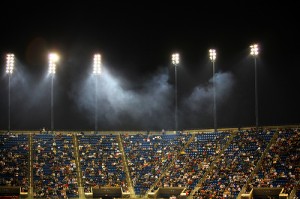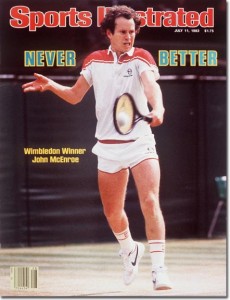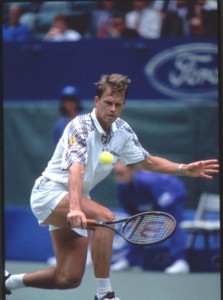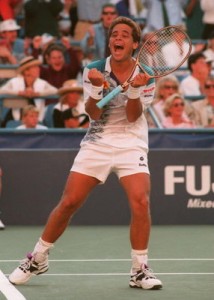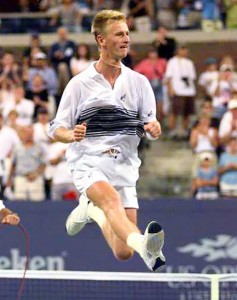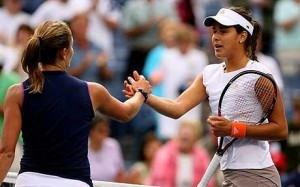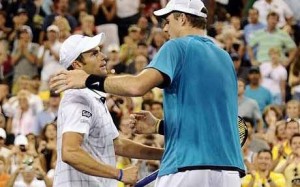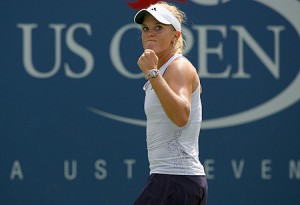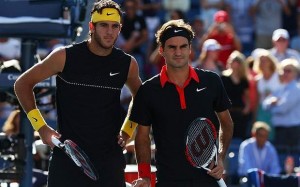What Have Been the Greatest Upsets in U.S. Open Tennis History?
Looking at the modern era or from 1968 forward, how many times has the number one seed or one of the top seeds gone down to defeat unexpectedly in New York during the U.S. Open? Here are some of the most famous upsets listed here in chronological order.
1975 Jimmy Connors (1) vs. Manuel Orantes (3), Finals
Ornates won 6-4, 6-3, 6-3. In 1975 Jimmy Connors, the No. 1 seed defeated his arch rival Bjorn Borg in the semifinals while Spain’s Manuel Orantes defeated the No. 2 seed Guillermo Vilas in a very difficult match to reach the final, facing Jimmy Connors. The Open at Forest Hills was being played on clay in 1975.
Connors was having a bad year, for him, losing his Australian Open crown to John Newcombe and his Wimbledon trophy to Arthur Ashe. His back was against the wall as the American faced the Spaniard Orantes, trying to retain his hold on the No. 1 ranking.
The clay surface obviously benefitted Orantes. But Connors had defeated the Spaniard in six of their last seven meetings and felt confident going into the match that he would win again.
Orantes never let the American into the match. The Spaniard played slow, denying Connors pace, never allowing him to establish a rhythm. Orantes lobbed and passed Connors at the net with amazing accuracy.
That is not to say that Connors quit trying but he did not have game enough to defeat the Spaniard that day. Connors lost his third slam championship of the year to the underdog Orantes in 1975.
1983 John McEnroe (1) vs. Bill Scanlon Round 4
Scanlon won 7-6, 7-6, 4-6, 6-4. John McEnroe, the No. 1 seed, ranked No. 1 in the world, went down to defeat at the hands of fellow American Bill Scanlon 7-6, 7-6, 4-6, 6-4, in the fourth round.
McEnroe had defeated Trey Waltke, John Sadri, and Vincent Van Patten before meeting Bill Scanlon in the fourth round. Scanlon had overcome Henrik Sundstrom, Chris Lewis and Pat Cash before facing McEnroe.
The match was to become the talk of the U.S. Open, marking the first time since 1977 that McEnroe had not made it to at least the semifinals of the Open.
The New York crowd backed Scanlon, much to the chagrin of native son McEnroe who was raised a mere 15 minutes from the stadium. As much as McEnroe wished to find fault with the crowds, the umpires, the lines people, the noise, the planes overhead, the heat and the stifling conditions––the fact is that McEnroe did not deliver the better play on the day and Scanlon defeated him, hands down, no excuses.
In the process, McEnroe won only 51 percent of his first serves, while committing 14 unforced errors, while double-faulting 10 times. You just cannot win with numbers like those––most of the time, anyway.
Scanlon took the win and ran with it. In fact, he took it all the way to the semifinals where he finally lost to eventual champion, Jimmy Connors.
1989 Mats Wilander (5) vs. Pete Sampras 1989, Round 2
Sampras wins 5-7, 6-3, 1-6, 6-1, 6-4. Mats Wilander’s pinnacle year was 1988 when he became the No. 1 player in the world. The Swede stole that moniker away from Ivan Lendl after defeating the Czech at the U.S. Open in 1988.
A year later, Wilander, seeded No. 5 and the defending champion, came into the Open not playing too well. In the second round he met an eighteen-year-old American, ranked No. 91, Pete Sampras.
Sampras served and came to the net each time, even though Sampras’ serve and volley game was not yet perfected. According to Mary Carillo, Sampras came to the net 160 times to Wilander’s 14. Carillo also reported that Wilander was 14-1 in five set Major finals coming into this match.
For Wilander it was a terrible match and the 25-year old Swede was at a loss to explain his slump during 1989. Sampras admitted that he caught Wilander at just the right time, taking advantage of the fact that the usually superlative Swede was playing poorly. Sampras’ serve and volley kept Wilander off balance as the American continued to apply pressure.
The Sampras serve was still his major weapon and he used it to great effect to defeat the defending champion who never again scaled the heights that took him to the No. 1 ranking in 1988. It was a fitting match with Sampras defeating Wilander––one on the way up and the other on the way down.
1989 John McEnroe (4) vs. Paul Haarhuis 1989, Round 2
Haarhuis wins 6-4, 4-6, 6-3, 7-5. Just as Sampras sent Wilander packing in 1989, Paul Haarhuis did the same to the No. 4 seed, John McEnroe. The Dutchman Haarhuis, ranked 115, thrashed McEnroe who had won the U.S. Open Championship four times.
But, also like Wilander, McEnroe was no longer the force he once was on tour even though McEnroe had been enjoying a resurgence of late. At Wimbledon in 1989, McEnroe had made it all the way to the semifinals.
Haarhuis, however, ended McEnroe’s trip down memory lane by outhitting him and out maneuvering the American on court. Haarhuis’ power game completely frustrated McEnroe who had no answers for the 23-year old who claimed that he came from Mars.
Just as with Sampras, Haarhuis won the match with his serve and by securing one break of serve in each of his three winning sets. Another power player tipped the balance against former champions as 1989 became the year of the upsets.
McEnroe called his own play “dead.” He felt he had just given in to the Dutchman without putting any effort into winning. It was a sad afternoon for the American who expected to do so much better but who never would make it back to a final again.
1990 Stefan Edberg (1) vs. Alexander Volkov 1990 – 1st round
Volkov wins 6-3, 7-6, 6-2. Stefan Edberg did not especially like it in New York.
The place was usually a jinx for him just as it had been for his countryman Bjorn Borg. But he was the No. 1 seed coming into the U.S. Open in 1990.
Alexander Volkov ranked No. 52 in the world had no high expectations for the Open––especially once he found out that he would face the No. 1 seed, the man who had just won Wimbledon in 1990, Stefan Edberg.
In fact, Volkov, so sure that he would lose, scheduled himself to play at a tournament in West Germany later in the week. He was to fly off on Wednesday.
But on Tuesday, the Russian upset the No. 1 seed, Stefan Edberg 6-3, 7-6, 6-2. Volkov had to change his flight plans becoming the first man in 19 years to defeat the No. 1 seed in the opening round.
During the match the Russian kept waiting for Edberg to come back, to take control of the match; but Edberg remained missing in action as he labored to make a match of it.
Edberg could not muster any speed, accuracy or ambition and let the Russian walk away with a surprising victory. Suffering from burnout, Edberg lost the match and the jinx continued.
Fortunately for Edberg, the Swede would come back and win the U.S. Open in 1991-1992, ending his bad luck forever.
1994 Pete Sampras (1) vs. Jaime Yzaga 1994, Round 4
The year was 1994 and the U.S. Open was underway. Pete Sampras was the defending champion and most expected him to repeat. He had, however, spent most of the summer battling tendinitis in his left ankle suffering complications with calcium deposits. This led the No. 1 ranked American to miss all the tune-up events leading up to the Open.
Sampras was hardly match strong coming into New York, but he did manage to defeat Kevin Ullyett in the first round, Daniel Vacek in the second, and Roger Smith in the third before he met Jaime Yzaga in the fourth round. Yzaga had met and defeated Gabriel Markus, David Witt, and Cedric Pioline before his encounter with Sampras.
The Peruvian was a counterpuncher and a scrambler who never quit on a point. This day it won him the match and his first quarterfinal berth in a Major. He was not sorry that he won––because Yzaga had earned it.
He was the better man on the day. True, Sampras was not in the best shape, but there are no special allowances given players. Once you step on the court, it is the best man who wins. Period.
We don’t record victories with asterisks saying Sampras had tendinitis in his ankle and could not move well. We note the winner was Jaime Yzaga.
But Sampras, who could have made it easy on himself, did not. The American fought for every point and contested every point on his opponent’s racket. He made the Peruvian earn his victory.
The fact is that Sampras hit the wall and had no energy, no flight left by the end of the match. But he kept fighting anyway.
Sampras refused as always to concede a match. He did not retire because he was hot or because he had blisters so bad he could not walk. He fought until the match was over and that is truly remarkable because how many times in today’s game do we see guys retiring because they are uncomfortable or in pain?
As defending champion, Sampras lost but he did not quit in 1994.
1997, Pete Sampras (1) vs. Peter Korda (15), Round 4
Korda won 6-7, 7-5,7-6,3-6, 7-6. Pete Sampras entered the U.S. Open as the No. 1 seed in 1997, fully expecting to win the title again, or at least make the final. Sampras, after all, had played in every final since 1994.
In the fourth round Sampras met the fifteenth seed Peter Korda from the Czech Republic. Korda had played Sampras tough during a five-setter at Wimbledon earlier that summer as the American held on to win.
Sampras gave Korda credit for his victory because the Czech came up with winning shots when he had to.
Sampras did not make it easy, firing 58 winners including 24 aces. The American even held a 3-0 advantage in the final set and seemed well on his way to securing his 17th consecutive match win at the U.S. Open.
But Korda had another ending in mind. After dealing with rain delays and the Sampras serve, Korda fought his way into a final set tiebreak––leaping out to a 4-0 lead over Sampras. Eventually Korda was able to serve it out and win the match.
Sampras would win the U.S. Open once more in 2002.
2000 Andre Agassi (1) vs. Arnaud Clement, 2000, Round 2
Clement 6-3, 6-2, 6-4. It was a brutal summer for the American Agassi who was seeded No. 1 coming into the U.S. Open in 2000. His mother had recently been diagnosed with breast cancer, a fate similarly suffered by his sister. Agassi had also hurt his back in a car accident and had, perhaps, not fully recovered from that.
But Agassi offered no excuses for his straight set loss at the hands of Frenchman Arnaud Clement 6-3, 6-2, 6-4, ranked No. 37 in the world.
It was the first year the championship would be played in the new Arthur Ashe Stadium.
Agassi’s play was passive and plodding, as if he did not expect to win and really did not care. He showed no energy and applied no effort in his straight set loss.
Clement recorded 36 winners on the day to Agassi’s 19. They each had 27 unforced errors but the difference was that Clement’s usually followed an attempt by the Frenchman to go for a winner while Agassi’s came generally on routine shots that the American was used to winning––shots he normally could make with his eyes closed.
While Clement played well, he did not perform brilliantly. He won the match and Agassi like other seeds Gustavo Kuerten and Patrick Rafter, faded away in the heat of the day.
2008 Ana Ivanovic (1) vs Julie Coin, 2008, Round 2. Coin wins 6-3, 4-6, 6-3
Julie Coin of France, ranked 188, had never played in a Grand Slam before appearing at the U.S. Open in 2008. Ana Ivanovic, winner of the 2008 French Open, seemingly the tour’s hottest new star, seemed to be fading away before the dew evaporated off her new-found stardom.
Previously that summer, Ivanovic lost in the third round of Wimbledon––then withdrew from the Olympics.
It marked the first time in forty years at the Open that the No. 1 seed on the women’s side of the draw lost in the second round. In 1966 when Billie Jean King was the top seed, she lost in the second round to Kerry Melville, 6-4, 6-4.
At the U.S. Open in 2008, the Serbian beauty met and defeated Vera Dushevina in a first round characterized by less than stellar play. But losing to Coin in the second round of the U.S. Open seemed to pound the nail into the coffin of her career. Ivanovic’s confidence and her ranking plummeted from that point forward.
Ivanovic admitted to being nervous about the match, having never played Coin before. Apparently, her anxiety affected her game so much, her serve and her ground strokes deserted her. Today Ivanovic continues to struggle to regain her edge.
2009 Andy Roddick (5) vs. John Isner, Round 3.
Isner won 7-6, 6-3, 3-6, 5-7, 7-6
Andy Roddick played the match of his life during the Wimbledon finals against his arch rival Roger Federer. During the match, Roddick lost his serve only once, in the last game of the match, allowing Federer to escape with another Wimbledon crown.
So coming into the U.S. Open Roddick had belief and crowd support. Everyone wanted Roddick to get the trophy he should have won at Wimbledon––everyone, except those opponents facing him at the Open in New York.
In the third round, Roddick faced fellow American John Isner, a towering 6 foot 9 giant with a blistering, punishing serve. Isner, ranked No. 55 in the world, came into the match with his own reserve of confidence.
The match which lasted almost four hours, kept the fans on the edge of their seats as the action ebbed and flowed. In the final set tiebreak, Isner served it out to win the match.
In reaching the fourth round, Isner served up 38 aces to thwart the ambitions of the No. 5 seed, Roddick. It was his biggest victory to date and the start up the ladder for Isner. For Roddick, it had the opposite effect. It began a downward trek which Roddick continues to deal with today.
2009 Melanie Oudin vs the Russians
In 2009 at the U.S. Open, a 17-year old from Marietta, Georgia, created her own one-woman juggernaut against the best Russian players in the world, taking them out one at a time in thrilling fashion.
The teenager had the American press in tow as they hyped and highlighted her matches at Flushing Meadows a year ago.
Her first victory came over Russian Anastasia Pavlyuchenkova in the first round where the American dominated 6-2, 6-1. Nobody much noticed.
But in the second round, Oudin met and defeated the fourth seed, Elena Dementieva in a stunner 5-7, 6-4, 6-3. The American’s next opponent in the third round was Maria Sharapova. Again, Oudin surprised everyone by taking out the Russian beauty 3-6, 6-4, 7-5.
That led Oudin to the fourth round where she faced Nadia Petrova with the winner to advance to the U.S. Open quarterfinals. Then, the 70th ranked player in the world struggled once again, after dropping the opening set to rally for a win against the determined Russian Petrova. Oudin won 1-6, 7-6, 6-3.
In the quarterfinals where she faced her first non-Russian opponent, Oudin lost. Dane Caroline Wozniacki defeated Oudin, ending her Cinderella run at the U.S. Open in 2009.
Since that tournament, Oudin has never enjoyed so much success and so much press but still very young, there is great hope that Oudin might become a factor on tour for American women.
2009 Roger Federer(1) vs Juan Martin del Potro (6), Final
Roger Federer had won the U.S. Open for the past five consecutive years but nothing lasts forever, not even for Roger Federer who seemed to own the U.S. Open Championship.
Juan Marin del Potro had to fight for his life in this match but he never relinquished his belief that he could defeat the man across the net, the world No. 1 Federer.
After all, Federer had not lost a match in New York for five years. The Swiss was in the final for the sixth consecutive year and hoping for a sixth consecutive win to tie him with Bill Tilden.
Besides Rafael Nadal, del Potro became only the second man in history to defeat Federer in a slam final.
Going into the match, Federer owned the young Argentine having won their first six contests. But del Potro seemed to learn from each of his losses and his confidence grew with each match.
Several times during the match, Federer held set points and match points, but unlike the Federer of old, this time del Potro fought his way back, finally casting Federer in the role of the vanquished.
In the semifinals del Potro demolished Nadal 6-2, 6-2, 6-2––sending notice to everyone that a new star was rising. The final was an amazing match to witness as it see-sawed back and forth, as each player seemed to be shutting the other down.
But the last and greatest ascendancy came in the fifth set when del Potro closed the door quickly denying Federer another opportunity to find a way to win.
Coming into the final this year, however, the Argentine will have his work cut out for him since he has been out most of the year recovering from wrist surgery.
His entry into the the 2010 U.S. Open is still uncertain, although there have been many reports that he has been hitting the practice courts.
All human beings in motion must come to rest at some point in time. Federer’s reign as the U.S. Open Champion was stilled for the moment in 2009. But perhaps, he will find a way to win there again – if nothing else – simply out of habit.
